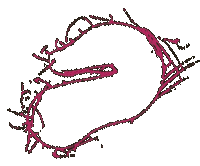October 07, 2003
if i'm writing about art, i'm not thinking about the bad things: elements of my kinesthetic experiences
If it's not visual communication, and it's not audible communication, and it's not written communication, then what is it?
I'm concerned with the feeling of experiencing my work, not an emotional feeling, but the physical one (though you can't completely separate them, another topic for later perhaps). For the moment, I'll call them kinesthetic experiences (kinesthetic communication?). While the experience is the main subject, the act doesn't stand alone. Several other factors contribute to the outcome. It's possible to remove these other factors and nullify the meaning and leave just the shell of a fun ride. First, these experiences have to happen in the context of a preexisting art setting. I wouldn't take my work out in the middle of a field and expect people to get the meaning. In an art space (i.e. gallery, museum), the participant approaches it already primed to think by being in this environment. I'm not one to trick the audience. I want my art to be approached knowing that it's art. That hints on the next element: approachability and guidance.
Most of my pieces would need to be attended by someone to prep people on how to use them. I've actually found that people are afraid and do too little, rather than unknowingly going too far with an apparatus when they don't know anything about it. These guides can ease some of these fears. They can also guide a mindset. Some of my pieces are merely to be played with, while some have a very specific set of movements to go through. Participants feel better when given permission to play or given, at minimum, an action to start with.
The last element for me is the visual aspect. The visual comes secondary to the action many times. I use this in several ways. Because I know not everyone will get to, or be able to try one of my pieces out for themselves, I consider how the setup and action looks to a viewing audience. You can get a good sense of what my pieces are about just from watching someone else go through the act. However, I want to keep it primarily an interaction, rather than a performance. As it goes, "doing is better than seeing." Another way I use it is to aid the mindset and approachability. These pieces exist in an otherwise blank environment, so their appearance creates much of the feeling of the space on it's own. Lastly, trained as a visual artist, I just have a need to make things pretty. Of course, it's all subjective, but I certainly don't want any aesthetic choices to be overlooked for fear of detracting from the concept.


